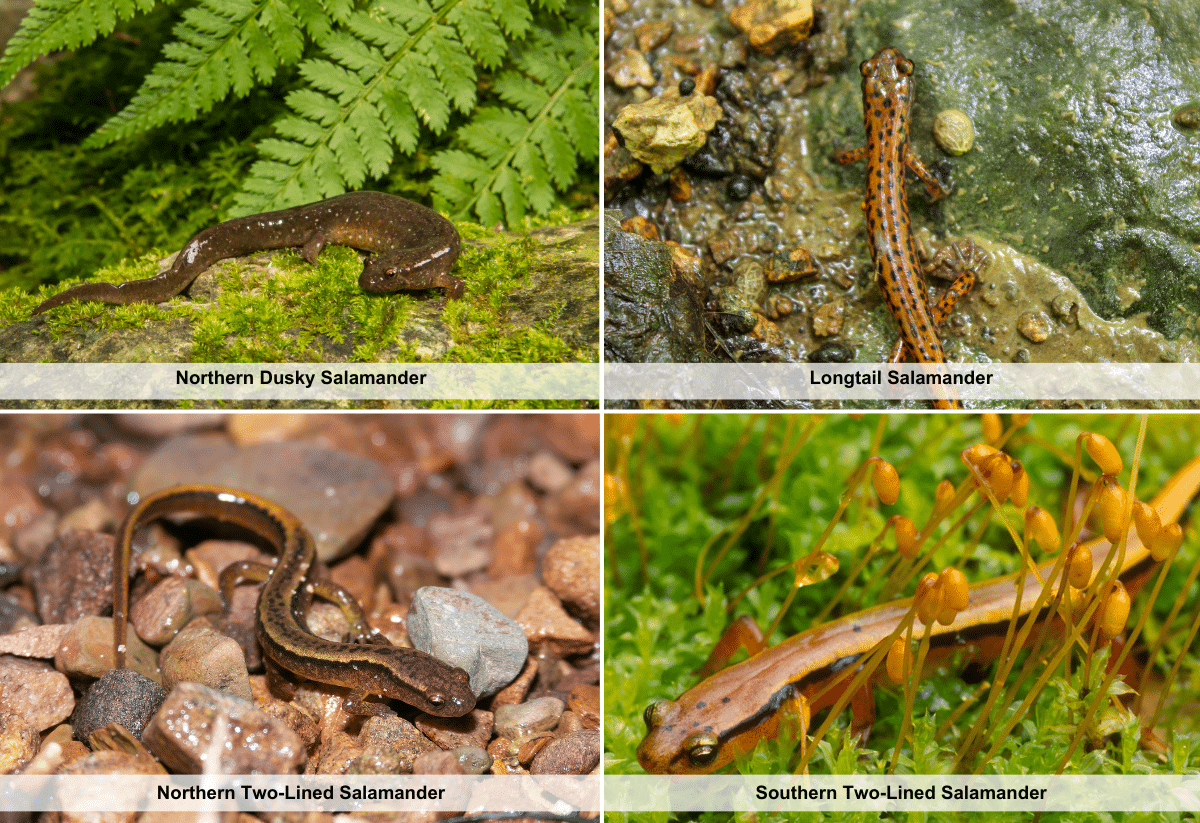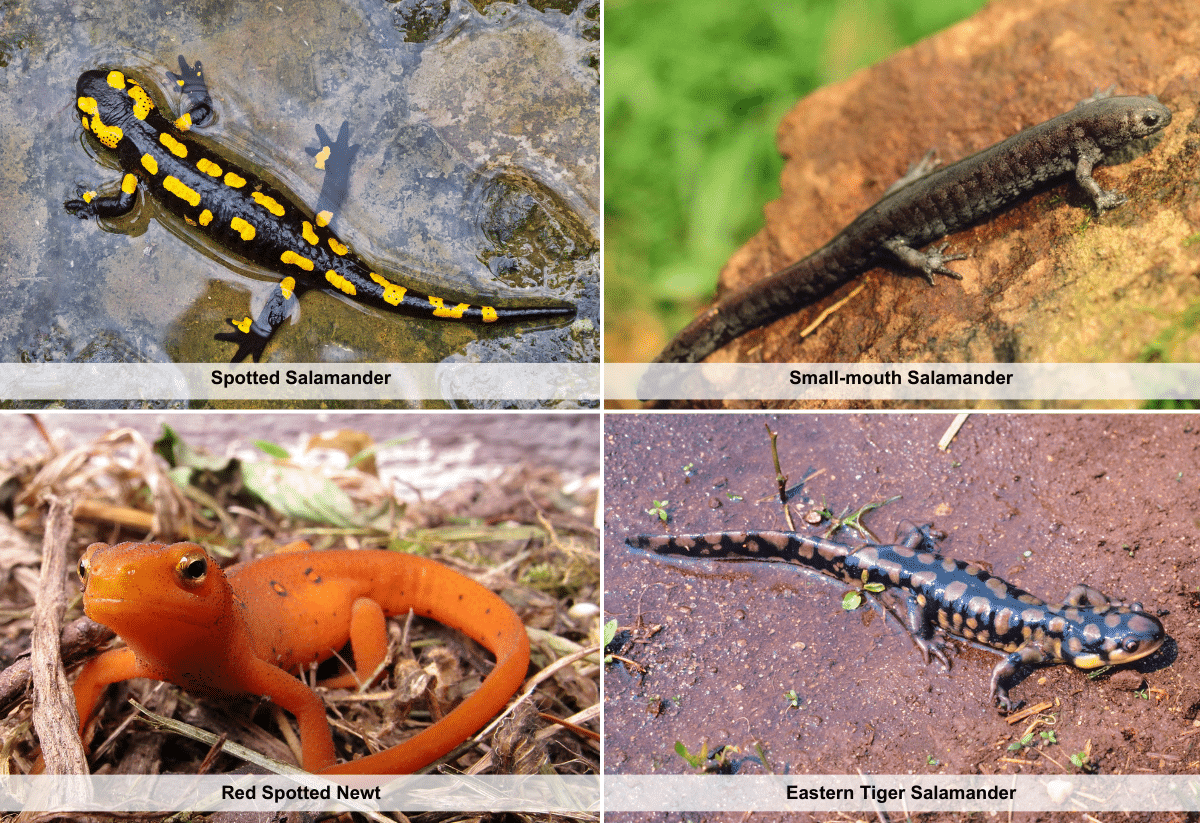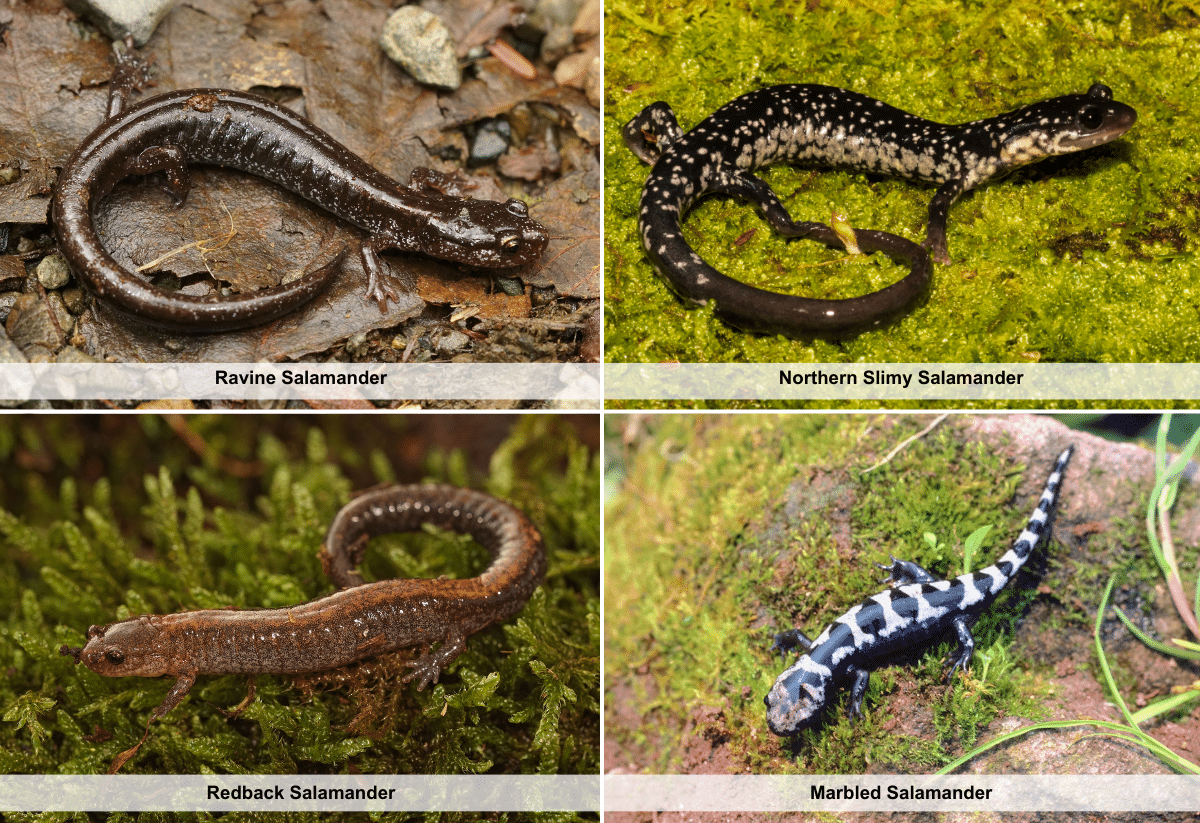Salamanders In Ohio
This post contains links to affiliate websites, such as Amazon, and we receive an affiliate commission for any purchases made by you using these links.
There are 24 species of Salamanders In Ohio. Some of which are very abundant! We take a look at 10 species of salamanders here and list the other 14 species.

About Salamanders in Ohio
Salamanders are amphibians, they often resemble lizards. Like lizards, salamanders usually have four legs that are at right angles to their body. They have slender bodies, short snouts, and a tail. Salamanders do not have scales, they have smooth skin which they need to keep cool and damp at all times.
Some species are fully aquatic for their entire lives, some are semi-aquatic taking to the water intermittently and some are fully terrestrial. Salamanders make no vocal sounds.
The eastern region of the US has the most diversity of species of salamander, particularly in the Appalachian regions. Ohio has 24 species of salamanders and newts, which is quite a diverse selection!
Cindy’s Insider Ohio Tips!
Salamanders need a cool and moist habitat, and they are very happy and active during and after rainfall. Therefore, the best time to spot salamanders is typically from October to March.
Salamanders: Flowing Water Habitats
Flowing water habitats include streams, creeks, springs, and rivers. Salamanders prefer spring-fed water sources with a constant supply of cold water. There are 12 species of salamanders in Ohio that require flowing water. Many of these species spend the majority of their adult lives in water.

Northern Dusky Salamander
- Color: Yellowish brown to dark brown
- Characteristics: Hindlimbs are larger than forelimbs
- Size: Up to 5½ inches long
- Breeding season:
- Lays eggs: July
- Eggs hatch: September
- Distribution: South and East Ohio
- Status: Abundant and widespread
Longtail Salamander
- Color: Yellow to orange with black spots
- Characteristics: The tail comprises two-thirds of its length
- Size: Up to 9 inches long
- Breeding season:
- Eggs laid: Early winter
- Eggs hatch: In 4-12 weeks
- Distribution: Southwest and East Ohio
- Status: Not a state-listed species
Northern and Southern Two-Lined Salamanders
- Color: Yellowish Green to Yellowish Brown
- Characteristics: Two black lines that run the length of their body
- Size: 3-5 inches long
- Breeding season:
- Eggs laid: May
- Eggs hatch: One month later
- Distribution: The Northern species is found above a line that extends from Knox County to Jefferson County. The Southern species is found below this line. Breeding between the two species does happen.
- Status: Widespread and locally abundant
More Salamanders in Flowing Water Habitats
- Mountain Dusky Salamander | Only found in the extreme northeast of Ohio
- Spring Salamander | Southern Ohio
- Midland Mud Salamander | Southeast Ohio | Threatened Species
- Northern Red Salamander | Eastern Ohio
- Cave Salamander | Southwest Ohio | Endangered Species
- Eastern Hellbender | The Ohio River | Endangered Species
- Streamside Salamander | Southwest Ohio
- Mudpuppy | Throughout Ohio, but rarely seen
Salamanders: Standing Water Habitats
Standing water habitats include vernal pools, bogs, swamp forests, ponds, and lakes. There are 8 species of salamanders in Ohio that prefer standing water habitats. The majority of these species are semi-aquatic.

A Short Video Of Common Salamanders That Can Be Found Near Standing Water:
Spotted Salamander
- Color: Brown with yellow spots
- Characteristics: Spots on the head can be orange. Eggs laid in water.
- Size: Up to 8 inches long
- Breeding season:
- Eggs laid: Late winter/early spring
- Eggs hatch: 4-7 weeks later
- Distribution: Throughout the state
- Status: Abundant
Small-mouth Salamander
- Color: Brown-black
- Size: 4-7 inches long
- Characteristics: A short snout and lower jaw. Eggs laid in water.
- Breeding season:
- Eggs laid: Late winter/early spring
- Eggs hatch: 3-4 weeks later
- Distribution: Northern Ohio
- Status: Widespread and common in some areas
Red Spotted Newt
- Color: Dark green with red spots (orange with red spots as a juvenile)
- Characteristics: The juvenile or ‘eft’ goes through a metamorphosis after 3-7 years before they become adult.
- Size: Up to 6 inches long
- Breeding season:
- Eggs laid: March-June
- Eggs hatch: 3-5 weeks later
- Distribution: Statewide, more common in South and East
- Status: Locally abundant in some areas
More Salamanders in Standing Water Habitats
- Jefferson Salamander | Found in a narrow band from South to Northeast Ohio
- Blue-Spotted Salamander | Northwest Ohio | Endangered Species
- Eastern Tiger Salamander | Mainly in the North of Ohio | Uncommon
- Four-Toed Salamander | Rare | Species of Special Concern
- Unisexual Salamander Complexes (mix of 2 or more species) | Statewide
Salamanders: Terrestrial Habitats
Terrestrial habitats are the cool, damp places in forests that can be found all over Ohio. There are eight species of salamanders in Ohio that live the majority of their lives on land.

Ravine Salamander
- Color: Dark brown to black with silver flecks
- Characteristics: One-half of the total length of this salamander is made up of its tail
- Size: Up to 6 inches long
- Breeding season:
- Eggs laid: Summer
- Eggs hatch: Late summer/early fall
- Distribution: South and East Ohio
- Status: Widespread and locally abundant
Northern Slimy Salamander
- Color: Black with white spots
- Characteristics: Emits white sticky secretions from its tail when disturbed
- Size: Up to 9 inches long
- Breeding season:
- Eggs laid: Summer
- Eggs hatch: 2-3 months later
- Distribution: East and South Ohio
- Status: Locally abundant
Redback Salamander
- Color: Black to dark brown, with or without an orange-red stripe on its back
- Characteristics: This salamander has short legs
- Breeding season:
- Eggs laid: June
- Eggs hatch: August
- Distribution: Throughout Ohio
- Status: Widespread and locally abundant
More Salamanders in Terrestrial Habitats
Green Salamander | Within 7 miles of the Ohio River | Endangered Species
Marbled Salamander | Statewide | Uncommon
Short Video Of A Redback Salamander:
State Endangered Salamanders in Ohio
There are four state-endangered species of salamanders in Ohio. The usual reasons for a species to become endangered are loss of habitat, pollution, predators, or disease.
- Cave Salamander
- Eastern Hellbender
- Blue-Spotted Salamander
- Green Salamander
There is also one threatened species. This species is not in immediate danger, but if the numbers continue to fall it will become endangered.
- The Midland Mud Salamander
Finding Salamanders in Ohio
Have you spotted any Salamanders in Ohio during your outdoor adventures? We’d love to know what species of salamanders you have spotted! Were you able to take any photographs? Drop us a comment below and let us know!
Check out our other articles on wildlife in Ohio – Caterpillars, Frogs, Turtles, and Garter Snakes.
Hello! We have done our very best to ensure that the accuracy of events, hours, addresses, etc, are up to date. Please know that information can change due to weather, updated health and safety challenges, etc. If you find incorrect information, please send us an email at [email protected], and we can get it updated.
To be updated and stay connected, subscribe to our newsletter.









hello, just a note. I had a visit this morning from a ravine salamander at my home in southwest Hardin co. I’ve lived on this property for 10 yrs. and have also found 2 blue spotted salamanders over that time. I didn’t get pics. of the blue spotted, didn’t realize at the time they are endangered.
Hello and good morning! Thank you for letting us know Kevin! I appreciate it!